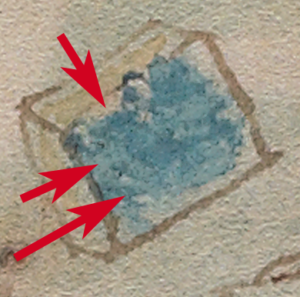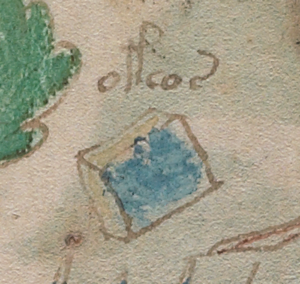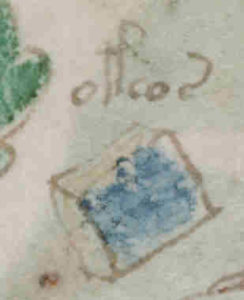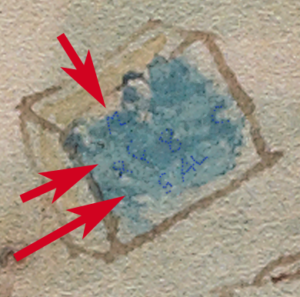Voynich researchers have been discussing the “blue cube” on the small plants page in the Voynich forum and there are various ideas about why this anomalous object is in a section dedicated to plants and objects that look like containers.
It’s painted blue and pale yellow and is roughly book-shaped.
I wanted to know what was under the paint, so I tried to remove the paint without disturbing the faint brownish lines underneath. This is difficult because brown also includes a certain amount of blue which tends to disappear when the overpainted blue is lightened.
I didn’t expect to find anything under the blue paint. I assumed those faint traces of brownish color were just lines but was very surprised when shapes emerged that resemble writing.
Is There Writing Out of the Blue?
There may be two, perhaps even three lines of text and I don’t know if they’ll be sufficiently visible in a blog pic. The first one (the top line) I can’t be sure. There’s a shape that resembles an “M” or possibly “a M” but it might be irregularities in the parchment where the paint tends to pool.
The second line is less ambiguous. It looks like Voynich characters. I can almost discern an EVA-ell, then something faint that’s hard to see, perhaps another EVA-ell or EVA-r or maybe it’s a space. The following glyph looks like a figure-8, then there’s a space, then a messy shape that looks a bit like a c-shape with a blotchy descender that probably isn’t a descender at all. It looks to me like a darker paint-brush stroke.
What’s even more surprising is that there seems to be another line at the bottom in another hand. It’s not small and neat like Voynichese, and it doesn’t look like Voynich characters. It’s reminiscent of the large straight angular block letter scribbles that are drawn by children, somewhat like the scribbles on a few of the VMS pages. It looks like it might be “S A L” which is “salt” in some languages, and which might apply to a cube in a page of plants. Salt was a preservative, an ingredient in medicinal recipes, and was, of course, used in food.
If you’re wondering if I projected an expectation of the word “salt” on the shapes, I think that’s unlikely. I shook my head when I first saw it. I thought the cube might represent some resin or mineral more commonly associated with various herbal compendiums and would not expect salt to be drawn this way.
I’m not claiming the cube is salt or even that this interpretation of the shapes is correct. Why would someone represent it as a cube and paint it blue? Why would the sides be yellow with an added line that makes it look like two blocks laminated together? Salt crystals are whitish, irregular and very small. They’re grainy like sand. Rock salt looks more cubical than modern table salt but it doesn’t look like this.
Summary
 So… I’m not absolutely sure it says SAL—maybe it’s “S AL” or a parchment wiggle followed by “AL” or pressure marks from a knife as are found in a few places in the manuscript. You can click on the thumbnail right to see the larger version).
So… I’m not absolutely sure it says SAL—maybe it’s “S AL” or a parchment wiggle followed by “AL” or pressure marks from a knife as are found in a few places in the manuscript. You can click on the thumbnail right to see the larger version).
I’m not sure of any of the text—but there’s something under the paint that appears darker and more systematic than irregularities in the vellum that I have tentatively marked with dots in the bottom image.
In medieval manuscript preparation, it was common to write a color name on an object that was later to be painted. Finding text isn’t unusual in itself, but this text doesn’t show any obvious signs of indicating color.
The only glyph that is reasonably clear (on the unmarked image) is the EVA-ell, and we have to remember that all of this is very small—the marks might be artifacts created by the texture of the vellum.
Once again, you’ll have to decide for yourself if there’s writing under the paint and what it might mean.
J.K. Petersen
© Copyright 2016 J.K. Petersen, All Rights Reserved



